Elements of a Negligence Case

A person who is injured because of the negligence of another party may be able to sue for damages to compensate him or her for the injury. In such cases, the injured party filing suit is known as the plaintiff, and the party that suit is filed against is known as the defendant.
The plaintiff has the burden of proof in a negligence case, meaning that to collect damages, the plaintiff must prove the four elements of negligence: duty, breach, causation and damages. Below is a discussion of each of these elements.
Duty
First, the injured party (called the plaintiff) must prove that the person being sued (the defendant) owed the injured person some sort of legal duty. The duty could arise based on several different factors, including the relationship between the plaintiff and the defendant, the activity the defendant was engaged in at the time of the accident, or the position of the defendant.
For example, a doctor owes a duty of care to her patients, a store owner owes a duty of care to its patrons to keep the store in reasonably safe condition, and the driver of a car owes a duty of care to passengers, pedestrians, and other motorists on the road.
Breach
Once a duty has been established, the plaintiff must establish that the defendant breached his or her duty by doing something he or she shouldn't have done or failing to do something he or she should have done. The standard which is usually applied is that of a "reasonably prudent person." In other words, to show that the defendant breached a duty to the plaintiff, the plaintiff must show that a reasonably prudent person in the same circumstances would have acted differently.
For example, if a store owner knew that the shelves in the store were overloaded and were likely break and cause injury to a store patron, the store owner would be found to have breached his or her duty of care to the store's patron who is injured as a result.
Causation
Next, the plaintiff has to prove that the defendant's breach of the duty to the plaintiff actually caused the occurrence and the plaintiff's injury. If the occurrence would have happened even if the defendant had not breached the duty of care to the plaintiff, the plaintiff will not be able to collect any damages from the defendant.
As part of this element of the case, the plaintiff must prove that it was "foreseeable" that an injury could occur if the defendant breached its duty of care. Random accidents, or accidents that could not possibly be predicted from the breach of the plaintiff's duty will be found to be "unforeseeable" and will prevent the plaintiff from recovering damages from the defendant.
For example, it would be foreseeable that a store patron could slip and fall in a puddle on the floor in the supermarket and get injured, but it might not be foreseeable that a shopper would see the puddle, turn his or her shopping cart around quickly to avoid it, and in doing so, strike and injure another store patron. In that case, the puddle might be a "but for" cause (but for the puddle, the shopper would not have turned quickly, hitting the other patron), but it is not the actual or "proximate" cause of the occurrence-which is the shopper quickly turning his or her cart. Negligence requires a finding of actual or proximate cause.
Damages
Finally, the plaintiff in a negligence case must prove that the occurrence caused some injury, either a physical injury or damage to property (if, for example, a store patron damages a car in the parking lot with their shopping cart). The fact that the defendant acted negligently toward someone to whom they owed a duty, and their negligence was the proximate cause of an accident is not enough - the accident must also have caused some actual damage.
If you believe you have suffered an injury or other damages because of someone else's negligence, let the perfect personal injury lawyer come to you by posting a short summary of your situation on our site.
Do You Need An Attorney?
If so, post a short summary of your legal needs to our site and let attorneys submit applications to fulfill those needs. No time wasted, no hassle, no confusion, no cost.

